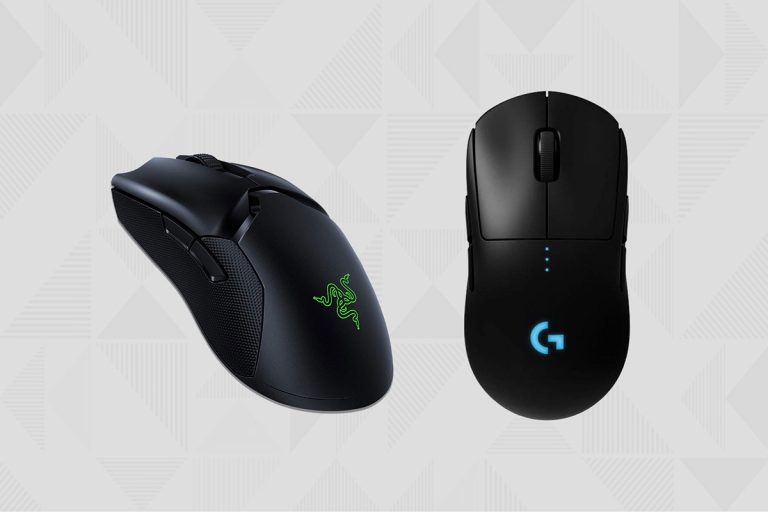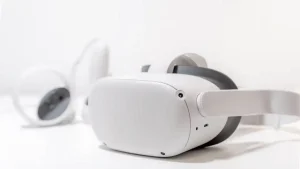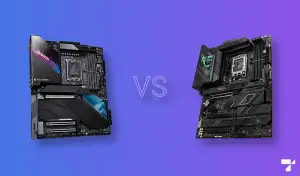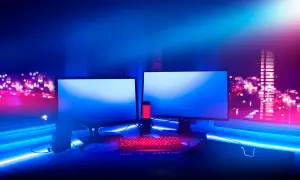A gaming mouse is the primary input device for PC gamers, which is why choosing the right one can make a massive difference. Additionally, a gaming mouse that is both lightweight and wireless is essential to performing well in the games you play due to less drag and quicker movements. Therefore, below we have curated a comprehensive list of the lightest wireless gaming mice.
If you are looking for the lightest wireless gaming mouse, in this article, we’ll discuss various options you should consider buying from multiple brands. In addition, we also discuss what you should look for when deciding on which lightweight wireless gaming mouse is ideal for your needs. Such as the mouse shapes, size, sensor, battery life, wireless technology, and much more.
Lightest Wireless Gaming Mice
1. Razer Viper V2 Pro
Verdict
If you’re looking for an ambidextrous design with a medium size, a great sensor, and plenty of functionality, the Viper V2 Pro is a great choice.
Specifications
Connectivity: Wireless + Wired | Sensor: Focus Pro 30K Optical | Switches: Optical Switches Gen-3 90M | DPI: 30,000 | Polling rate: 4,000Hz | Programmable Buttons: 5 | Weight: 58g (Black), 59g (White) | Size: Medium | Length: 4.98 inches | Grip width: 2.61 inches | Orientation: AmbidextrousBenefits
- 80-hour battery life
- HyperSpeed lag-free wireless
- Ambidextrous design
Drawbacks
- Not as cheap
- RGB needs to be off to achieve long battery life
Razer has been around for a good while, with some nice mice options like the extremely popular DeathAdder. However, when it comes to a wireless gaming mouse, nothing beats the Viper V2 Pro. It’s an excellent mouse made to cater to a variety of users, and it has all the specs and features you would expect.
One thing we love about it is that it uses Razer’s HyperSpeed technology. With wireless mice, latency has always been an issue, but HyperSpeed eliminates it completely, making for mice that perform just as well as wired ones in terms of latency. You won’t find this with many other mice, which is why the Viper V2 Pro is one of if not the highest recommended lightest wireless gaming mouse models.
At the heart of the Viper V2 Pro is Razer’s 30,000 DPI Focus Pro sensor. This is an extremely accurate sensor that tracks very well and is perfect for games like FPS, where quick reaction times are important and you can’t afford to compromise. It’s one of the best sensors Razer has ever used in a mouse, which does speak volumes.
There’s another thing that’s impressive about the Viper V2 Pro, and that’s the weight. While wireless mice are usually heavier due to the battery and the other tech that’s inside, the Viper V2 Pro tips the scales at only 58 or 59 grams, which is very lightweight.
When you factor in that you get all of this in an ambidextrous design, with an 80-hour battery, there’s no reason not to go for it.
2. Logitech G PRO X Superlight
Verdict
This is a “Superlight” light wireless mouse at under 63 grams with a meticulously designed shape and a fast sensor, the Logitech G PRO X Superlight is a great choice.
Specifications
Connectivity: Wireless | Sensor: Logitech HERO 25K | Switches: Omron 20M | DPI: 25,600 | Polling rate: 1,000Hz | Programmable Buttons: 5 | Weight: 63g | Size: Medium | Length: 4.9 inches | Grip width: 2.5 inches | Orientation: Symmetrical right-handedBenefits
- One of the lightest wireless mice
- PTFE feet for excellent glide
- Compatibility with PowerPlay charging
Drawbacks
- Very expensive
- No RGB lighting
While the original G PRO was one of Logitech’s best mice, a lot of people complained that it was a tad too heavy. With that in mind, Logitech has produced the G PRO X Superlight, a lightweight wireless gaming mouse version of the G PRO that keeps all the important functionalities but reduces the weight to an impressive 63 grams.
The sensor inside is Logitech’s latest and greatest HERO 25K sensor, which means you get incredible accuracy and tracking, as well as up to 25,000 DPI. We have no idea if anyone even uses DPI that high, but it’s there if you need it. The wireless performance is top-notch as well, thanks to Logitech’s Lightspeed technology that’s just as quick to react as a wired mouse.
One of the things Logitech has done to reduce weight is to remove the buttons on the right of the mouse. You only get two buttons on the left, which you can program and set up to do pretty much anything you want. Another thing that’s gone is RGB – the lighting is heavy and Logitech removed it to further reduce weight.
At the bottom, you’ll find massive PTFE feet, which deliver some of the smoothest glides when it comes to stock mice feet. Simply put, If you are in search of the lightest wireless gaming mouse and like the form factor of the G PRO, you’ll love the G PRO X Superlight. It’s a similar mouse, just lighter and even more accurate.
3. Finalmouse Starlight Pro TenZ
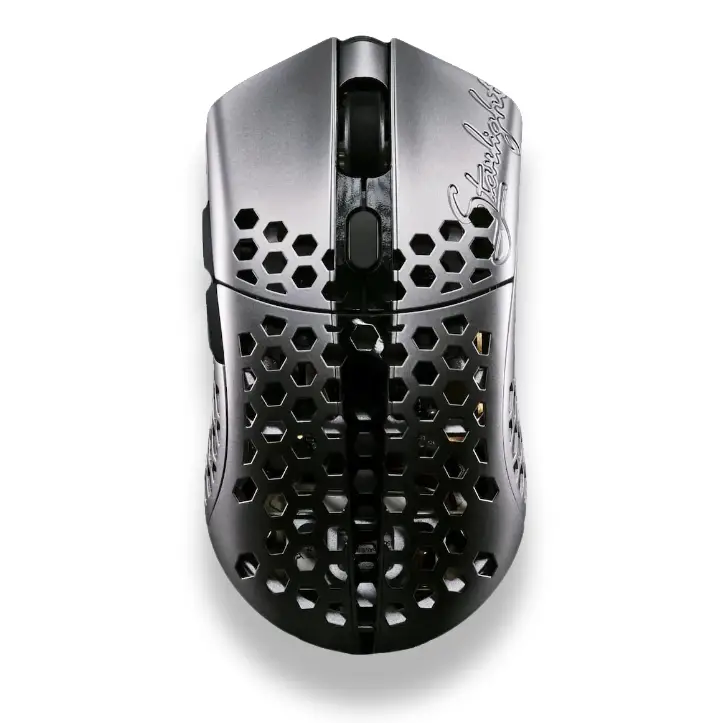
Verdict
Though very expensive and difficult to get your hands on, the Starlight Pro Tenz is an extremely lightweight wireless gaming mouse at a mere 42 grams, performs well, and looks very beautiful.
Specifications
Connectivity: Wireless | Sensor: Finalsensor Optical | Switches: Kailh GM 8.0 80M | DPI: 20,000 | Polling rate: 1,000Hz | Programmable Buttons: 6 | Weight: 42g | Size: Small | Length: 4.42 inches | Grip width: 2.1 inches | Orientation: Symmetrical Right-handedBenefits
- Extremely lightweight at only 42g
- Beautiful design and overall build quality
- Very long battery life
Drawbacks
- Very expensive
Starlight Pro Tenz checks a lot of boxes for enthusiasts who want the absolute lightest wireless gaming mouse out there. On the outside, it’s made of a magnesium alloy and has a honeycomb shape to keep the weight low, but that design is absolutely beautiful.
In fact, this uniquely designed lightweight wireless mouse comes in a premium chrome finish with a fine “Starlight” engraving. It is almost unlike anything else on the market. Its claimed weight is 42 grams, but even Finalmouse claims that due to the manufacturing process, the weight can vary a couple of grams. Still impressively lightweight and feels very good in the hand.
When it comes to performance, Finalmouse includes its own Finalsensor which goes up to 20,000 DPI and tracks very well. Their Godspeed wireless technology is based on a Nordic RF platform, with custom, in-house developed firmware, and the wireless performance is on par with any other lag-free wireless mouse.
And while there is no Bluetooth, which some manufacturers use for extended battery life, the Starlight Pro Tenz can reach up to 160 hours of continuous use, which is impressive.
Overall, the Starlight Pro TenZ is a beautiful mouse that’s as lightweight as they come and performs admirably in any kind of game, but the high price tag and the fact that there is no software so you can program the buttons make it less-than-ideal for many.
4. Razer DeathAdder V3 Pro
Verdict
This mouse changes the typical Razer game with slightly modified curves and focus on overall size. Very accurate performance, but may not be suited for smaller-handed users.
Specifications
Connectivity: Wireless | Sensor: Focus Pro 30K Optical | Switches: Optical Switches Gen-3 90M | DPI: 30,000 | Polling rate: 1,000Hz (normal) 4,000Hz (Hyper mode) | Programmable Buttons: 5+1 | Weight: 63g | Size: Medium | Length: 5.1 inches | Grip width: 2.65 inches | Orientation: Right-handedBenefits
- Very lightweight
- Superb build quality
- Outstanding low click latency
Drawbacks
- Bulky, more recommended for larger hands
- No Razer Chroma RGB
The Razer DeathAdder V3 Pro is a function-optimized version compared to previous models. Aside from a significant weight reduction from 88g to 63g making it one of the lightest wireless gaming mice out there, it uses an updated sensor compared to the DeathAdder V2 Pro, combined with the latest proprietary optical switches. More notably, its curves (or lack thereof) are considerably different. It’s a bit flatter, while still being built for right-handed users.
The V3 Pro’s Focus Pro 30K gets a somewhat slight boost in its gliding sensation over the older Focus sensor. This does not change its overall accuracy, however, and if there was a difference, it was not distinct enough to be felt in actual gameplay. 30,000 DPI and 4,000Hz polling rate are as usual, already more than overkill compared to the rest of the competition. But it is still there in the rare case that it is needed.
One rather weird quirk of this mouse is its bulky feel. Despite the reduced curves and slashed-off weight, which provided a marked improvement in overall ergonomics, it may not be the best gaming mouse for those with smaller hands. The shape is also a tad bit wonky when fitting into cases. Certainly not the type that would fit elegantly into a laptop bag.
Following its minimalistic build is the lack of RGB. So no Razer Chroma support here. On the bright side, this does prolong the already amazing battery life of this gaming mouse even further. This allows for longer sessions of uninterrupted play throughout the entire week.
5. Cooler Master MM712
Verdict
The MM712 retains excellence in general use, with equal performance points for most types of game genres. Its competitive features become even more impressive with its price.
Specifications
Connectivity: Hybrid Wireless | Sensor: Pixart PAW3370 Optical | Switches: Optical Micro Switches 70M | DPI: 19,000 | Polling rate: 1,000Hz (2.4Ghz/wired) 125Hz (Bluetooth) | Programmable Buttons: 6 | Weight: 59g | Size: Medium | Length: 4.59 inches | Grip width: 2.46 inches | Orientation: Symmetric Right-handedBenefits
- Very comfy to use
- Practical specs for the price
- Great for small-handed users
Drawbacks
- DPI cycle button is under the mouse
- Occasionally weird post-travel activation
Cooler Master’s MM712 is introduced as a good quality lightweight gaming mouse that focuses on price-to-performance. Indeed, with its slew of optical micro switches and PAW3370 primary sensor, along with good build quality, it’s already set to make its introductory price well worth a casual gamer’s investment.
This mouse has an overall good neutral shape compared to the MM711 and MM731. This makes it versatile for any hand size but works particularly well for medium to small-sized hands. With a good palm grip, the user can easily leverage its gliding speed and accuracy, balanced further by its 59g of total weight. This makes one of the lightest wireless gaming mice that is also quite cost-effective. We just wish that the DPI cycle button wasn’t on the underside.
19,000 DPI doesn’t seem impressive, but let’s face it; anything more than 8,000 is generally overkill except for the highest competitive levels. Besides, the MM712 is best treated as an ace all-rounder; an affordable daily driver that can effectively be used for high-level gaming should the need arise.
In fact, its universal potential is enhanced further with its three different modes of connectivity. Not only does it cater to all usage scenarios, but swapping devices quickly becomes convenient, even without more premium features such as dual Bluetooth connections. All without noticeable effects on its durable battery life. Therefore, if you are looking for the lightest wireless gaming mouse you can find, but are on a budget, Cooler Master’s MM712 is a fantastic option.
6. Razer Orochi V2
Verdict
For people who require a high performance low-profile light wireless gaming mouse with portability, the Orochi V2 is a great choice, especially if you have small to medium sized hands due to its compact shape.
Specifications
Connectivity: Wireless | Sensor: Razer Optical Sensor | Switches: Razer Mechanical | DPI: 18,000 | Polling rate: 1,000Hz | Programmable Buttons: 6 | Weight: 60g | Size: Small | Length: 4.25 inches | Grip width: 2.3 inches | Orientation: Symmetrical right-handedBenefits
- Up to 950 hours battery on Bluetooth Low Energy
- Razer Mechanical Switches
- Durable PTFE feet
Drawbacks
- Small shape is not ideal for everyone
When it comes to the lightest wireless gaming mouse, the Orochi V2 has to be mentioned simply because of its very low price, great performance, shape, and relatively low weight. Razer’s original Orochi was a massive success. It was meant to be a portable mouse you could throw in your bag alongside your laptop and whip it out at a LAN party. But the Razer Orochi V2 improves on it in every possible way. It is the ideal option for small to medium size hand users that want a lightweight wireless gaming mouse that’s still great as a daily driver.
The shape is symmetrical, but it’s made for right-handed users because the only two side buttons are on the left side of the mouse. This isn’t a first for Razer, but considering they wanted to keep pricing reasonable, we don’t blame them for this. The weight is only 60 grams, but with a AA battery installed it moves up to about 72g. The scroll wheel is excellent, with a rubberized surface that’s grippy and works well. And we also love the switches, which are some of the most durable switches you can get nowadays.
Performance-wise, you get an 18,000 DPI optical sensor, which is solid and can be used paired with Razer’s HyperSpeed wireless technology. This way, you have up to 425 hours of battery and lag-free, precise gaming. But if you need it for day-to-day use, Bluetooth Low Energy doubles the battery life and introduces a minimal amount of latency. Overall, if you have small hands (or want a portable mouse), Razer’s Orochi V2 is an excellent choice. This is a mouse I personally use the most as I travel a lot along with the Razer Viper.
What to look for in a lightweight wireless gaming mouse
When you’re looking for the lightest wireless gaming mouse, there are a couple of factors that might make or break the entire experience more than just the mouse’s weight. If you skip any of them, you may find yourself with a lightweight wireless gaming mouse you don’t enjoy using. Therefore, you must also apply these factors below to your search for the lightest wireless gaming mouse you can find that fits your budget.
Shape and weight
There’s one thing that applies to just about any mouse in the world – if it doesn’t fit your hand well, it’s not going to work for you. Hand sizes are different for people, and so are hand shapes and preferred grip styles. What works for a medium hand and claw grip might not work for a medium hand and palm grip, and there are many combinations like this. This is why it’s good general advice to try the mouse before you buy it. However, if you’re already using a mouse with a shape that’s similar to the one you’re buying, you could just see how much of a difference there is by looking at the dimensions.
Weight is another thing that’s an individual thing, but in the past couple of years, it seems as if gamers are pushing for lighter mice. With wireless, this used to be a problem because you needed to host the transmitter and battery, which do add a bit of weight, but brands like Razer and Logitech have found ways to make sure this isn’t too much of a problem. Just look at the Viper Ultimate – it’s wireless, it’s latency-free, and it still weighs only 74 grams. This used to be a problem with wired mice a few years ago, and look at where we are now.
Wireless technology
One big reason why gamers, especially competitive ones, avoided wireless mice is that they always introduced some kind of latency. This was a major problem, but fortunately, one that is now rectified. The first one to solve this was Logitech with their Lightspeed wireless technology, which works wonderfully and is about the same as using a wired mouse. Other brands are catching up, too, like Corsair with SLIPSTREAM or Razer with HyperSpeed.
What should be kept in mind here is that you should steer clear of mice who don’t use such technology, or rely on Bluetooth for connectivity. Such mice will definitely introduce some kind of latency, and you want to avoid this when gaming. You can learn more about wireless mouse technology here.
Sensor, buttons, and switches
These three are the “performance” combination when it comes to mice – if one of them doesn’t perform well, you’ll feel it instantly, and you won’t be satisfied with your mouse. Mouse sensors tend to be rather accurate nowadays though, and anything by reputable names does a great job in that regard.
With buttons and switches, it’s all a matter of finding a layout that works for you. The switches in most higher-end mice are rated for at least 50 million clicks, so they’re as durable as they come, and you won’t be worrying too much here.
Make sure you get a mouse with side buttons that are placed well, and that there are enough of them for your use case. Some might do with only two, but others might require a few more buttons, which is where mice like the G Pro Wireless are a great choice.
Battery life and charging
Last but not least, wireless = battery, and you don’t want your mouse to die on you while gaming, do you? Long battery life is critical for a gaming mouse, which is why most of the options we would recommend tend to have upwards of 40 hours of battery life.
The way your mouse charges will have an impact here, too. While there are still mice that use AA or AAA batteries that you just swap out, most mice will require you to plug them in to charge. Most mice will also continue working as normal when they’re plugged in and charging, and some might even switch to a wired mode to charge faster.
Final Thoughts
These are the lightest wireless gaming mice you should consider. They have been proven to just be very good to great in all the factors discussed above and are all highly rated by the vast majority of their users. Therefore, we hope that you found this article helpful in your search for the lightest wireless gaming mouse out there.
